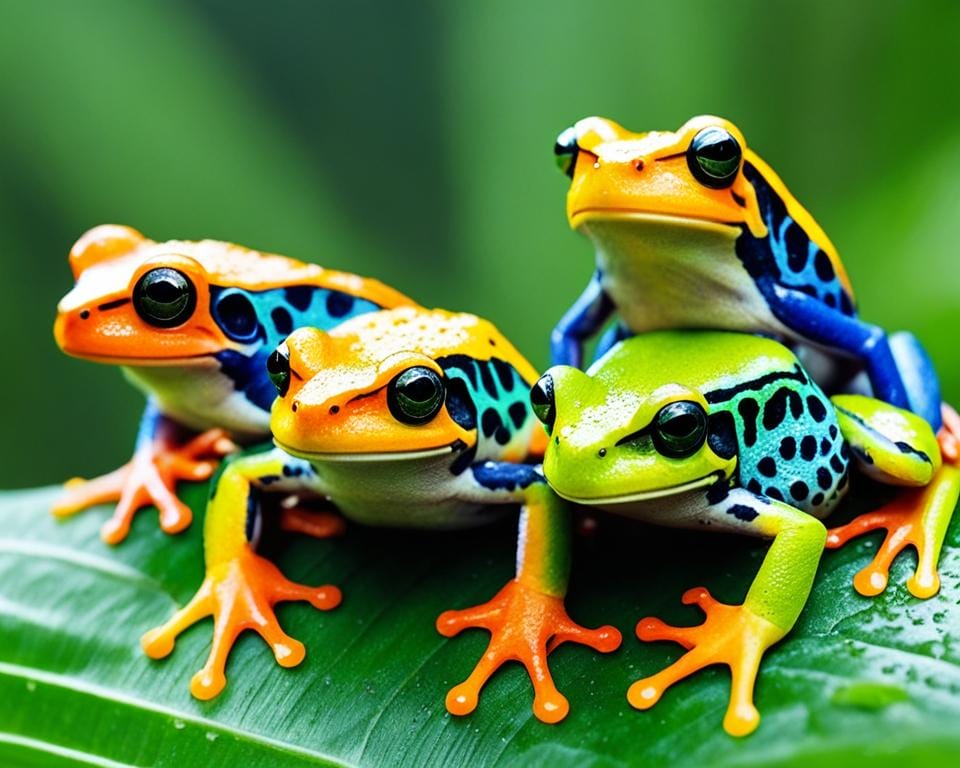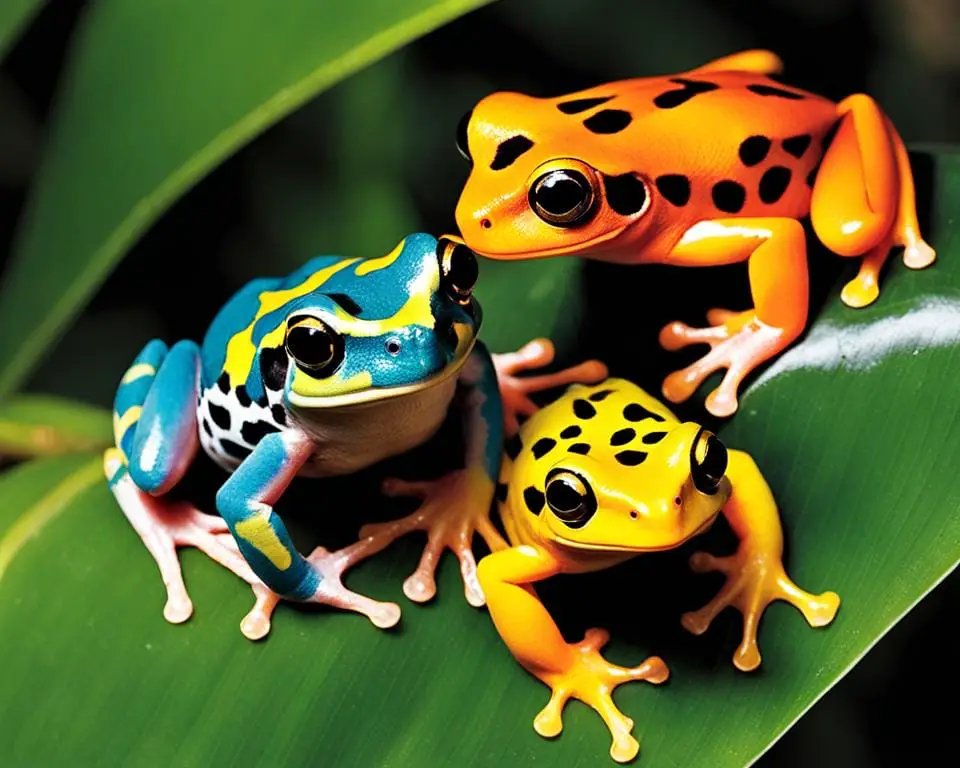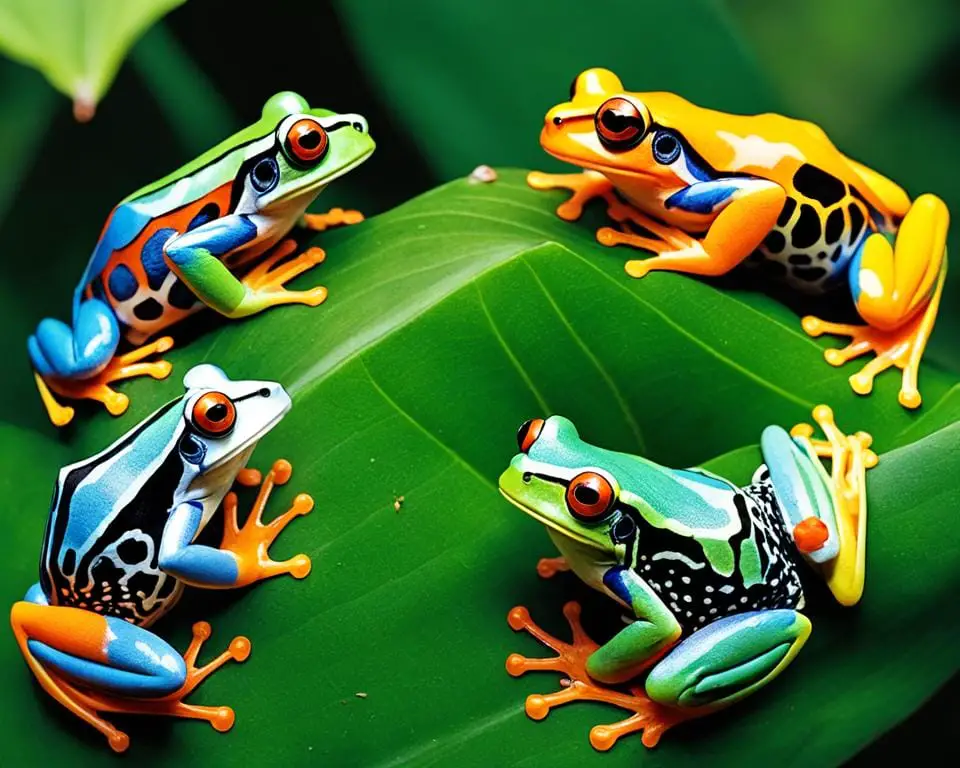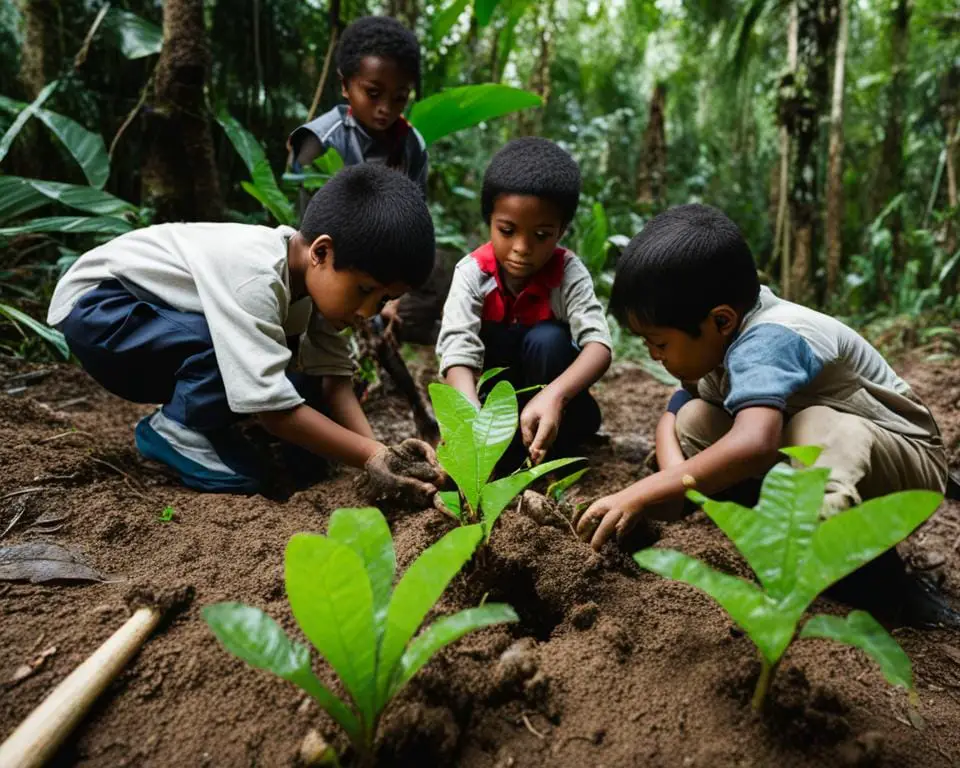
Clown Tree Frogs: Colorful Amphibian Wonders
Clown tree frogs are fascinating creatures that captivate amphibian enthusiasts with their vibrant colors and unique physical traits. In this comprehensive habitat and care guide, we will explore the world of these colorful frogs, their native habitat, and the key aspects of providing optimal care for them. Whether you are a beginner or an experienced amphibian enthusiast, this guide will provide valuable insights into the captivating world of clown tree frogs.
Key Takeaways:
- Clown tree frogs are known for their striking color patterns and unique physical traits.
- They are native to Central America and parts of Brazil and Colombia.
- Their native habitat consists of tropical rainforests and temporary forest pools.
- Clown tree frogs are nocturnal and arboreal, spending most of their time climbing in trees and vegetation.
- Creating an ideal home for them involves a taller vivarium with controlled ventilation, live plants, and climbing materials.
The Vibrant World of Clown Tree Frogs
Native Habitat and Species Overview
Clown tree frogs, native to Central America and parts of Brazil and Colombia, thrive in the lush tropical rainforests of their habitat. They can be found in areas with temporary forest pools, known as “floating meadows,” covered in abundant aquatic vegetation. This unique habitat provides them with the perfect environment to thrive and reproduce.
Nocturnal and Arboreal Lifestyle
One of the fascinating aspects of clown tree frogs is their nocturnal nature. These captivating creatures become active at night when they venture out of their hiding spots in trees and vegetation. With their unique color patterns and vibrant hues, clown tree frogs blend seamlessly into their surroundings, making them difficult to spot. Their arboreal lifestyle ensures that they spend most of their time climbing and leaping among the branches and leaves of trees.
Unique Color Patterns and Physical Traits
Clown tree frogs are known for their striking and vibrant color patterns, which vary significantly among individuals and can range from bold reds and yellows to deep blacks and earthy tans. This diversity in color makes each frog unique and adds to their allure. In addition to their vibrant hues, these tree frogs possess other unique physical traits, including their small size, typically measuring around 3/4 of an inch in length. Their diminutive stature makes them all the more charming and captivating to observe.
With their native habitat, nocturnal and arboreal lifestyle, vibrant color patterns, and unique physical traits, clown tree frogs are a true wonder of the amphibian world. Understanding their natural habitat and lifestyle is crucial for providing them with the care and environment they need to thrive in captivity.
Creating the Ideal Home for Clown Tree Frogs
To provide the best care for your clown tree frogs, it’s important to create an ideal habitat setup. A taller vivarium with a minimum height of 30 inches is recommended, allowing enough space for these arboreal frogs to climb and explore. Controlled ventilation is crucial to maintain a higher humidity level within the enclosure.
Utilizing a screen top and ventilation ports on the front of the terrarium can help achieve this. Live plants and climbing materials, such as branches and vines, should be included to mimic their natural environment and provide cover for the frogs. The substrate should consist of coconut husk or sphagnum moss to retain moisture and promote humidity levels conducive to their needs.

Creating a comfortable and visually appealing environment that resembles their natural habitat is essential for the well-being of clown tree frogs. With a taller vivarium, controlled ventilation, live plants, and the right substrate, you can ensure these vibrant amphibians have a suitable home to thrive in.
Captive Bred vs Wild Caught Clown Tree Frogs
When considering clown tree frogs as pets, there are two main options to consider: captive bred or wild caught. Understanding the differences between these two options is crucial for responsible ownership and conservation efforts.
1. Captive Bred Clown Tree Frogs:
Captive bred clown tree frogs are bred in captivity and are generally preferred for the pet trade. These frogs have been acclimated to captive conditions and are more likely to be healthy and well-suited for a home environment. Captive bred frogs are the result of controlled breeding programs, where breeders carefully select healthy individuals to create strong genetic lines. By choosing captive bred frogs, you are supporting responsible breeding practices and the conservation of wild populations.
2. Wild Caught Clown Tree Frogs:
On the other hand, wild caught clown tree frogs are collected from their natural habitats. While these frogs may be more readily available in the pet trade, they are often subjected to stress during the collection and transportation process. Wild caught frogs may also have a higher risk of carrying diseases or parasites compared to their captive bred counterparts. It is crucial to prioritize the welfare and conservation of wild populations by minimizing the demand for wild caught frogs.
By choosing captive bred clown tree frogs, you are not only promoting their well-being but also contributing to the sustainability of the pet trade. Responsible ownership and the support of reputable breeders play a vital role in the conservation of clown tree frogs and their natural habitats.

Feeding and Nutrition: What Clown Tree Frogs Eat
Ensuring proper feeding and nutrition is essential for the health and well-being of clown tree frogs. These vibrant amphibians are insectivores, relying on a diet primarily composed of live insects. Providing a varied and balanced diet is crucial to meet their nutritional needs.
Preferred Insect Diet and Supplements
Clown tree frogs have a diverse palate when it comes to insects. Their preferred food includes crickets, grasshoppers, moths, and other small invertebrates. It’s important to offer a variety of insects to provide different nutrients and prevent dietary deficiencies.

In addition to their insect diet, supplements play a crucial role in ensuring clown tree frogs receive the necessary vitamins and minerals. Gut loading is a method where the insects are fed nutritious foods before being offered to the frogs. This ensures that the insects have a higher concentration of nutrients, which are then passed on to the frogs. Calcium and multivitamin supplements can also be dusted onto the insects before feeding, ensuring that the frogs receive adequate nutrition.
The Importance of Gut Loading and Vitamin Dusting
Gut loading and vitamin dusting are essential practices to support the overall health of clown tree frogs. These techniques ensure that the frogs receive proper nutrition, including calcium for strong bones and multivitamins for overall health and well-being.
Gut loading not only benefits the frogs but also improves the nutritional value of the insects themselves. By feeding the insects a nutritious diet consisting of fruits, vegetables, and specially formulated insect gut-loading diets, the insects become a rich source of vitamins and minerals. When the frogs consume these insects, they benefit from the enhanced nutritional content.
Vitamin dusting involves coating the insects with calcium and multivitamin supplements. This ensures that the frogs receive essential nutrients that may be lacking in their insect diet. Dusting the insects with supplements before feeding them to the frogs is a simple and effective way to meet their nutritional needs.
Proper feeding practices, including gut loading and vitamin dusting, are vital for maintaining the health and overall well-being of clown tree frogs. By providing a varied insect diet and ensuring the supplementation of essential nutrients, you can help your frogs thrive in captivity.
Conservation Efforts and Responsible Pet Trade
Clown tree frogs are not only fascinating pets but also valuable inhabitants of our natural ecosystems. To ensure their continued existence in the wild, various conservation efforts have been implemented, and responsible pet trade practices play a vital role in their protection.
Understanding CITES Regulations
In the realm of international trade, the Convention on International Trade in Endangered Species of Wild Fauna and Flora (CITES) plays a crucial role in safeguarding the welfare and conservation of clown tree frogs and other threatened species. CITES is an international agreement between governments that aims to regulate and monitor the trade of endangered plants and animals to prevent overexploitation.
When acquiring and caring for clown tree frogs, it is essential to understand and abide by the regulations set forth by CITES. These regulations are in place to ensure that the trade in these frogs is sustainable and does not pose a threat to their survival in their natural habitats.
Fostering a Sustainable Future for Clown Tree Frogs
Responsible ownership of clown tree frogs goes beyond adhering to CITES regulations. By actively supporting and participating in captive breeding programs, we contribute to the conservation and sustainable preservation of these remarkable amphibians.
In addition to supporting captive breeding efforts, promoting sustainable practices in the pet trade industry is crucial. This includes encouraging responsible sourcing of clown tree frogs from reputable breeders who prioritize the welfare of the frogs and ensure their health and well-being throughout the breeding and transportation process.
As conscientious pet owners, it is essential to avoid purchasing illegally collected or traded clown tree frogs. By doing so, we help combat the illegal wildlife trade and protect these frogs from further population decline.
By fostering a sustainable future for clown tree frogs and other amphibians, we can make a significant impact on the preservation of their natural habitats and contribute to their long-term survival.

Conclusion
Clown tree frogs are remarkable and captivating amphibians that bring vibrant colors and unique personality to any amphibian enthusiast’s collection. This comprehensive guide has provided valuable insights into their native habitat, ideal care requirements, feeding and nutrition needs, and the importance of conservation efforts.
By following the tips and guidelines outlined in this guide, you can create a thriving and enriching environment for these colorful wonders of the amphibian world. Whether you are a beginner or an experienced pet owner, caring for clown tree frogs can be a rewarding and fulfilling experience.
Remember to provide a taller vivarium with ample climbing materials, proper ventilation, and humidity levels to mimic their natural habitat. Additionally, offer a varied diet of live insects and ensure they are gut loaded and vitamin dusted for nutritional balance. Lastly, support responsible breeding programs and adhere to CITES regulations to contribute to the conservation and sustainable future of clown tree frogs.
FAQ
Q: What is a popular species of clown tree frogs you can buy from us?
A: One popular species of clown tree frogs that you can buy from us is the dendropsophus leucophyllatus, also known as the clown treefrog. It’s a quaint yet captivating species common around human settlements and frequently featured in Reptiles Magazine.
Q: Can you provide a care sheet for dendropsophus leucophyllatus?
A: Yes, we can provide a comprehensive care sheet for your dendropsophus leucophyllatus. This includes information on housing, feeding, water changes and other specific care needs for this type of clown tree frog. All the information is based on research from various resources including Josh’s Frogs, an authority on reptiles and amphibians.
Q: What does a clown tree frog require in its habitat?
A: Clown tree frogs require a couple of things in their habitat. An aquarium with plenty of space at the top of the enclosure is essential. Additionally, a large water dish for soaking and a feeding dish for their feeder insects is required. Keeping their environment moist but not stagnant is crucial, adding to a sort of rain chamber effect.
Q: What are the sex differences in clown tree frogs?
A: Normally, female clown tree frogs are larger than males. This species also has a distinctive raspy call, consisting of a harsh primary note followed immediately by several equally stark secondary ones. This call is predominantly made by the males.
Q: Where are dendropsophus leucophyllatus found?
A: The dendropsophus leucophyllatus is native to South America. They are found in regions such as Suriname and French Guiana. They are fairly common around human settlements, making them an accessible pet reptile.
Q: What is the giraffe phase in clown tree frog care?
A: The “giraffe phase” is a term used to describe a stage in the growth of a dendropsophus leucophyllatus tadpole. During this phase, the tadpole develops longer legs and starts to resemble a giraffe. After this point, it starts to metamorphose into a froglet, which is a young frog.
Q: Are clown tree frogs active during the daytime?
A: Clown tree frogs are nocturnal, so they’re not active during the daytime. This is something keepers should take into account when planning their care and schedule.
Q: How can I buy a clown tree frog from you where it is a live animal?
A: If you wish to buy a live clown tree frog from us, you can give us a call at 1-800-691-8178 or head to one of our partnered FedEx Ship Centers. We take the utmost care in packing and shipping our live animals to ensure they reach you in the healthiest condition.
Q: How do clown tree frogs deposit eggs?
A: Clown tree frogs deposit eggs in the water, usually sticking them to the bottom of the enclosure or floating leaves. This is one of the important information to take into account when setting up an ideal clown tree frog enclosure.
Q: Where can I find more about the care and habitat for clown tree frogs?
A: You can find more detailed information about clown tree frog care in our care sheet, accessible through our site. Josh’s Frogs also provides extensive information on reptile and amphibian care, making it an excellent resource. Lastly, articles and features on clown tree frogs are occasionally featured on Reptiles Magazine, giving keepers a broader perspective on the species.
